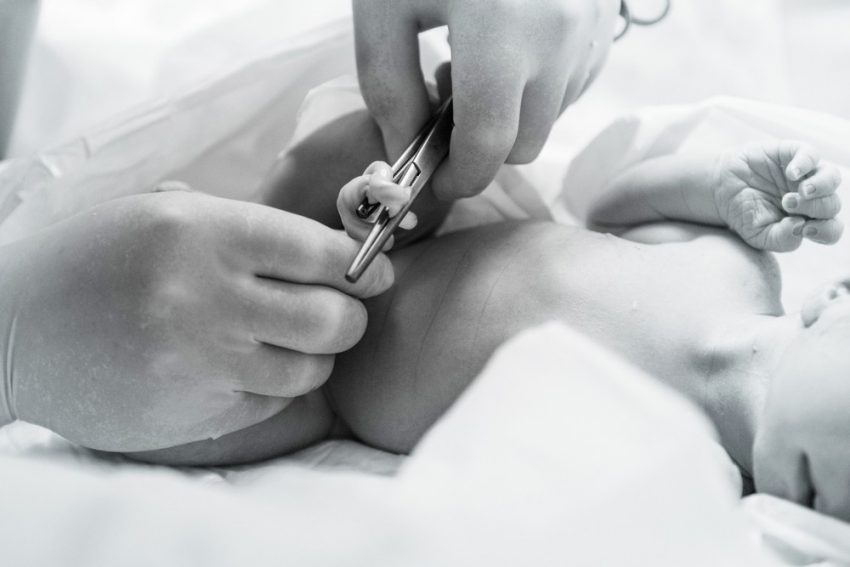What is delayed cord clamping?
The umbilical cord is the means of connecting the baby and the mother. The average length of a cord reaches 70 cm and it has 2 arteries and one vein. With the birth of the baby, the cord continues to thaw and gives oxygenated blood from the placenta to the newborn. Oxygenated blood moves into the infant’s lung; the cardiac output to the lung changes from 8–10% in the uterus to 45% in the immediate newborn period and demands an increased blood volume. This helps the first few minutes of his life until his lungs function properly and begin to oxygenate through breathing as he will for the rest of his life.
In the past, immediate cord clamping was normal practice in preterm infants because of concerns about harm from delayed resuscitation, hypothermia, hyperbilirubinemia, or polycythemia. Modern research has not only shown that delayed umbilical cord clamping has only positive but also that direct cord ligation, direct after childbirth, puts the baby at risk and it is a bad practice in most cases.
The ligation of the umbilical cord helps to start life as an independent entity. Late cord clamping (performed approximately 1–3 min after birth) is recommended for all births, while initiating simultaneous essential neonatal care.
which are the guidelines about DCC?
Various professional guidelines nowadays recommend delays of more than 30 seconds, 30 to 60 seconds, at least 60 seconds, or 30 to 180 seconds, all if resuscitation is unnecessary. The American College of Obstetricians and Gynecologists (ACOG) recommends delayed cord clamping (DCC) in both term and preterm pregnancies. Delayed cord clamping in the term infant is associated with increased hemoglobin levels at birth (about 2.2 g/dL higher) and better iron stores with less than a half the chance of iron deficiency in infants in the first three to six months of life, compared with early cord clamping (ECC). Other organizations, including the World Health Organization, American Academy of Pediatrics, Royal College of Obstetricians and Gynaecologists, and American College of Nurse‐Midwives, also recommend DCC, with varying end points, up to 2–5 min after birth.
It is advisable to wait to clamp the cord until the newborn starts to ventilate, and infants who experience a delay in establishing breathing after birth obtain a real cardiovascular benefit from DCC. Also the Royal College of Midwives published research in a 2015 report that says, ‘Immediate cord clamping reduces the flow of blood to the baby and can deprive the baby of iron. Iron deficiency in the first few months is associated with neurodevelopmental delay.
📷appleblossomfamilies- doula photographer
Which are the benefits of delayed umbilical cord clamping?
- The baby will have more blood volume, more iron and less chance of anemia.(delayed ligation of the umbilical cord by 2 minutes may increase iron stores by 24-27mg, which corresponds to the baby’s need for 1-2 months.), (a full-term neonate is born with, the total volume of iron can reach 115–125 mg/kg of body weight)
- Reduced risk of transfusion, necrotizing enterocolitis and cerebral haemorrhage (particularly important if the newborn is premature).
- Reduced risk for umbilical cord infections.
- Faster and longer duration of first breastfeeding.
- Smoother cardiopulmonary transmission after birth.
- In premature or low-weight neonates, the benefits are pretty good, including reducing the risk of intra-regional bleeding, and necrotizing enterocolitis, reducing the need for blood transfusions and using bronchodilators, increasing hematocrit, blood pressure, and blood flow.
We must be very clear. This blood is not Cord blood, it is BABY blood. When we ask mothers to give away cord blood, they are under an illusion. This blood belongs to the BABY, not the umbilical cord.
–Ibu Robin Lim
When is the correct time for delayed cord clamping?
Delayed cord clamping is one of the choices that you can report to your birth plan even if you deliver with caesarean section, normal birth or you have a premature baby. The only cases where delayed ligation is not feasible are when there is doubt about the integrity of the placenta or umbilical cord, or if the newborn has a heartbeat below 60 bpm, which does not improve. Health organizations, also note that delayed cord clamping does slightly increase the risk of elevated bilirubin levels causing jaundice or a yellowish skin tone in newborns, which is treated with ultraviolet lights. In any case delayed cord clamping is not harmful for you and your child.
Because Information is the key to success in all areas of our lives inform your care provider for your wishes through your birth plan.
– Early Versus Delayed Umbilical Cord Clamping on Physiologic Anemia of the Term Newborn Infant, Fatma Alzaree et all, Open Access Macedonian Journal of Medical Sciences. 2018 Aug 20; 6(8):1399-1404
– Delayed cord clamping and cord gas analysis at birth, Xodo S,Acta Obstet Gynecol Scand. 2018 Jan;97(1):7-1
– Delayed Umbilical cord clamping after Birth, ACOG, January 2017,Maria A Mascola MD, et all.
– Delayed umbilical cord clamping for improved maternal and infant health and nutrition outcomes. Geneva: World Health Organization; 2014.



